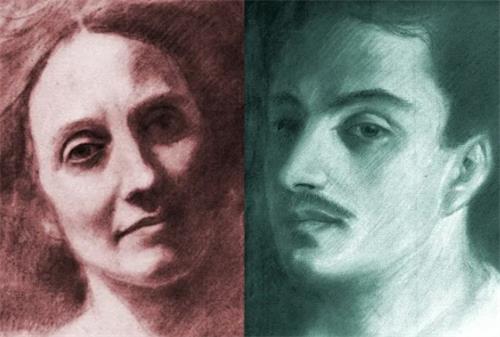
Gibran, an outstanding poet, painter, and writer of the 20th century, lived a life filled with romantic literary and artistic creations. Yet, he also experienced a profound love story—one that transcended cultural and temporal boundaries, brimming with longing, anticipation, and helplessness.
Born into a poor family in Lebanon, Gibran faced a difficult childhood. His father's alcoholism plunged the family into deeper hardship. In 1891, after his father was wrongfully imprisoned, the family's financial situation deteriorated further. His mother decided to take him and his siblings to the United States. During their three years in Boston, Gibran witnessed his mother’s relentless labor, yet their struggles persisted. To ease his mother’s burden, 15-year-old Gibran chose to return to Lebanon to further his studies, focusing on Arabic literature.
However, fate was not kind to him. In 1899, he lost his brother and younger sister, and soon after, his mother also passed away. Faced with overwhelming loss and debt, Gibran returned to the U.S., beginning a difficult new chapter of his life. He survived by selling paintings, writing articles, and taking odd jobs, relying on the support of friends to get by. In Boston, he met Mary—a sophisticated and intelligent headmistress, ten years his senior.
Mary warmly invited Gibran to the gatherings she hosted, though his modest and unassuming demeanor made him stand out among the refined guests. Yet, instead of dismissing him for his appearance, Mary welcomed him and took notice of his talent. Over time, she grew to admire his literary gifts and became both his confidante and supporter.
Understanding his financial struggles, Mary offered to sponsor his further studies in Paris. While deeply grateful, Gibran was also conflicted—he knew this was a significant expense, and he wondered how he could ever repay her kindness. Seeing his hesitation, Mary reassured him gently, saying, “Believe in yourself. You will succeed. And perhaps one day, I may need your help too.”
Encouraged by Mary, Gibran set off for Paris. Though separated by distance, their bond deepened through frequent letters. With her support, Gibran found a larger stage for his artistic pursuits. As their relationship grew, he developed a deep emotional attachment to her and eventually entertained the idea of spending his life with her. When he completed his studies in Paris and returned to the U.S. for the third time, he was determined to propose.
However, when Gibran finally confessed his love and proposed, Mary hesitated. Though she loved him, she understood that his future lay in a much broader world, and she feared that her older age might become an obstacle to his success. After much contemplation, she declined his proposal. In her diary, she wrote: “I love you, but pure love does not allow me to shape your future. There is a long road ahead of you, and I am merely a step on your path to growth.”
Gibran was deeply conflicted—disappointed yet understanding of Mary’s reasoning. He later moved to New York, seeking his place in the artistic and literary world. Despite the hardships he faced, he remained devoted to his craft. Meanwhile, Mary often visited New York, and the two maintained a strong friendship and continued corresponding. Mary not only provided him with selfless support in life but also offered invaluable guidance in his artistic and literary endeavors.
Though they never ended up together, their love was a sacred bond of the soul. Mary once predicted that Gibran would eventually meet someone who truly resonated with his spirit, a woman who would become the muse for his art. Her prediction came true—Gibran did find his kindred soul, inspiring some of his most immortal works.
The love between Gibran and Mary transcended the physical—it was a connection of the soul. Though they never became life partners, their story remains a timeless classic. Mary’s selfless love and support helped Gibran rise from hardship to artistic greatness, while Gibran carried Mary’s gentleness and wisdom in his heart, honoring it through his lifelong literary and artistic journey.

Mysterious Phenomena
7 Mysterious Phenomena That Once Baffled Scientists Are Now Solved
In the journey of scientific exploration, certain mysterious phenomena have long puzzled researchers. However, as studies advanced, many of these enigmas were eventually unraveled.

Atlantis
Atlantis—A Mythical Tale or a Real Lost Civilization?
Atlantis, one of the most famous lost civilizations in the world, continues to hold an important place in the research of historians, archaeologists, and mythologists.

Pygmalion,Galatea
From Sculpture to True Love: The Miraculous Romance of Pygmalion and Galatea
In a peaceful town on the island of Cyprus, there lived a sculptor named Pygmalion. Gifted with extraordinary talent, his sculpting skills were admired by many.


